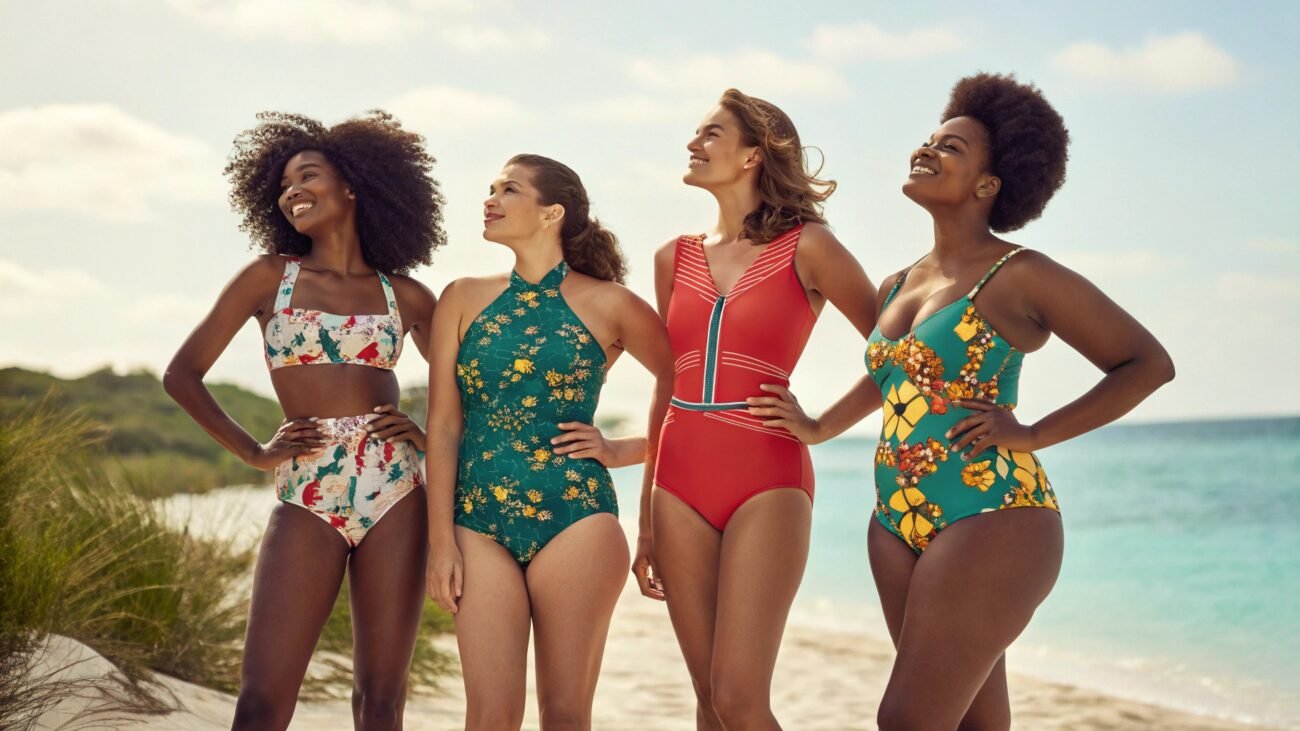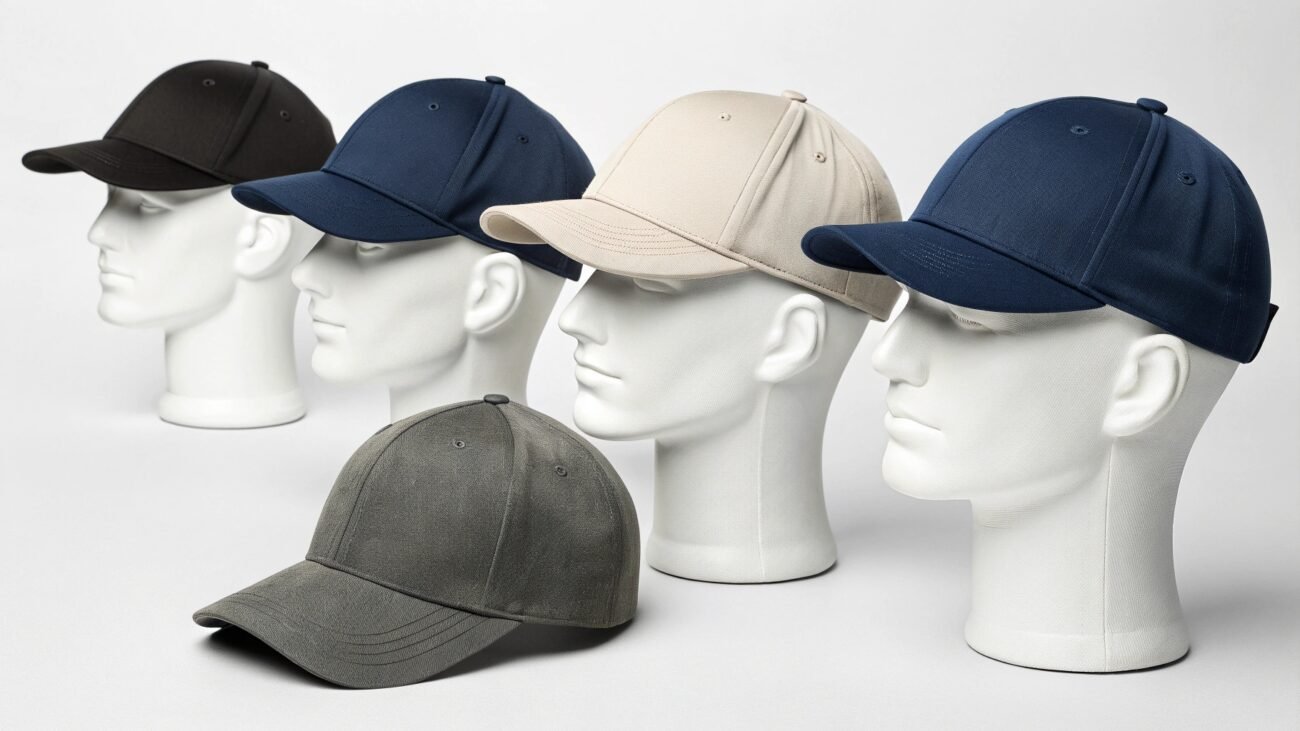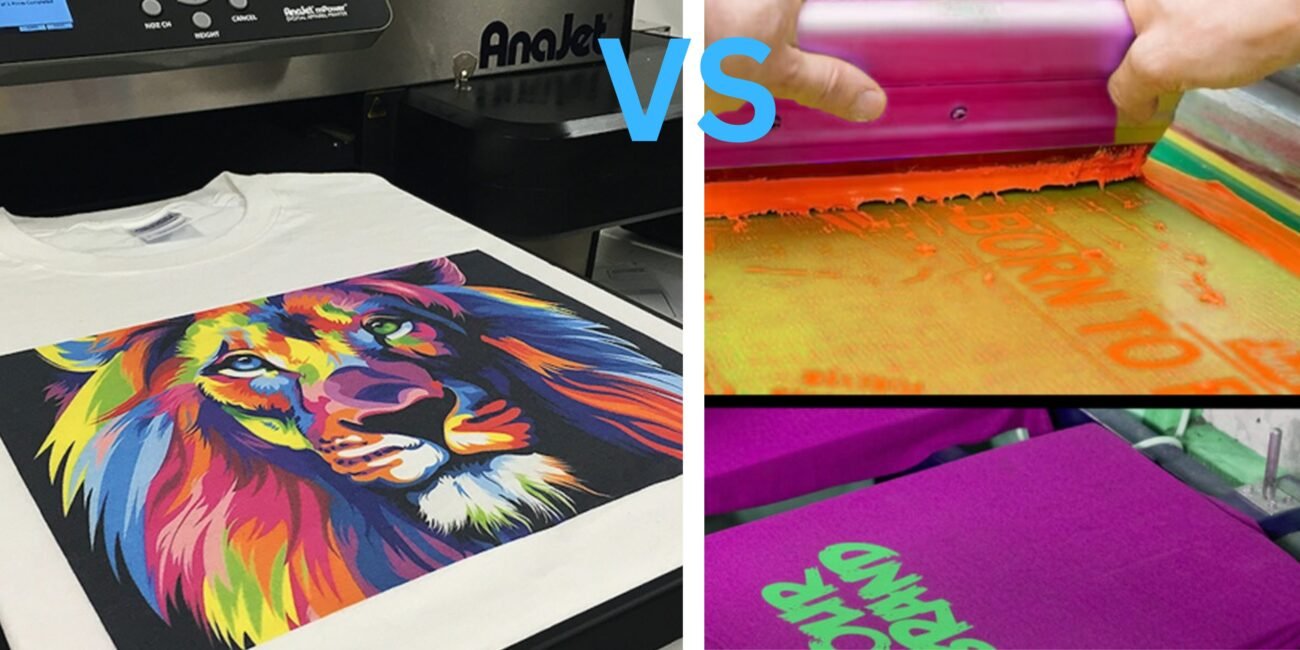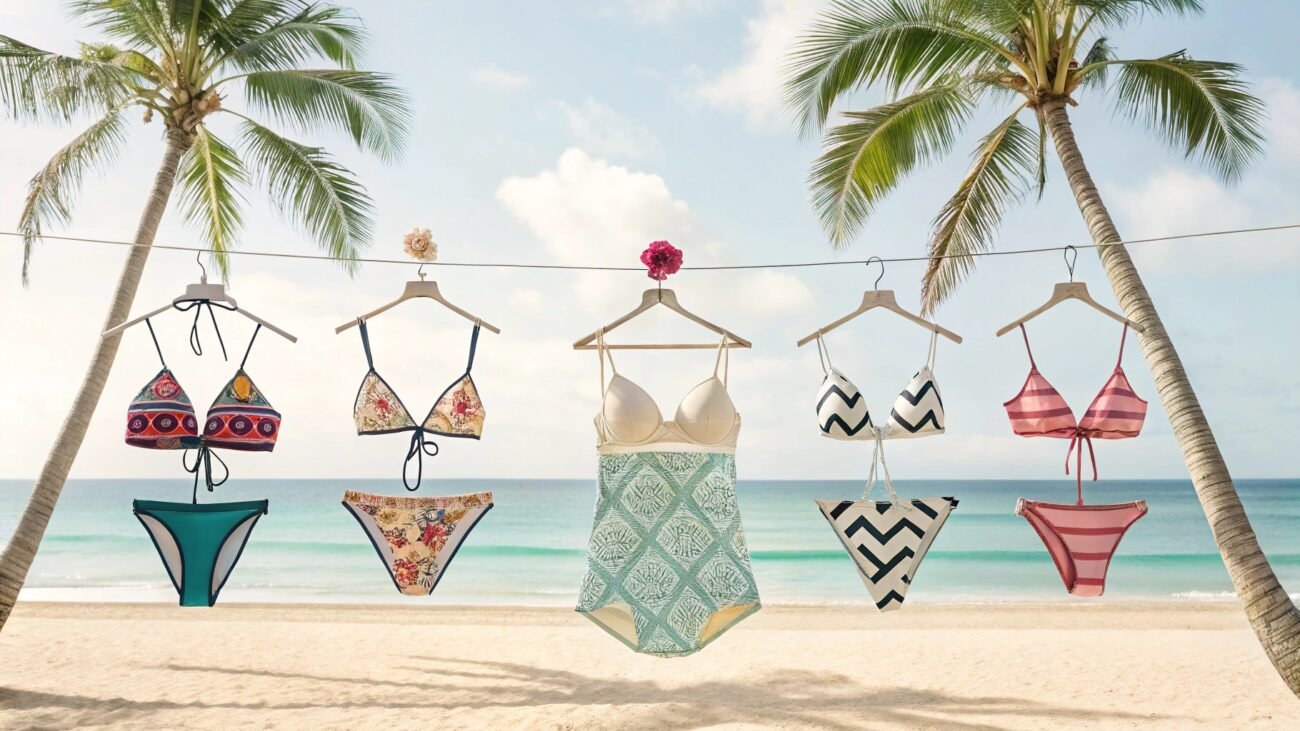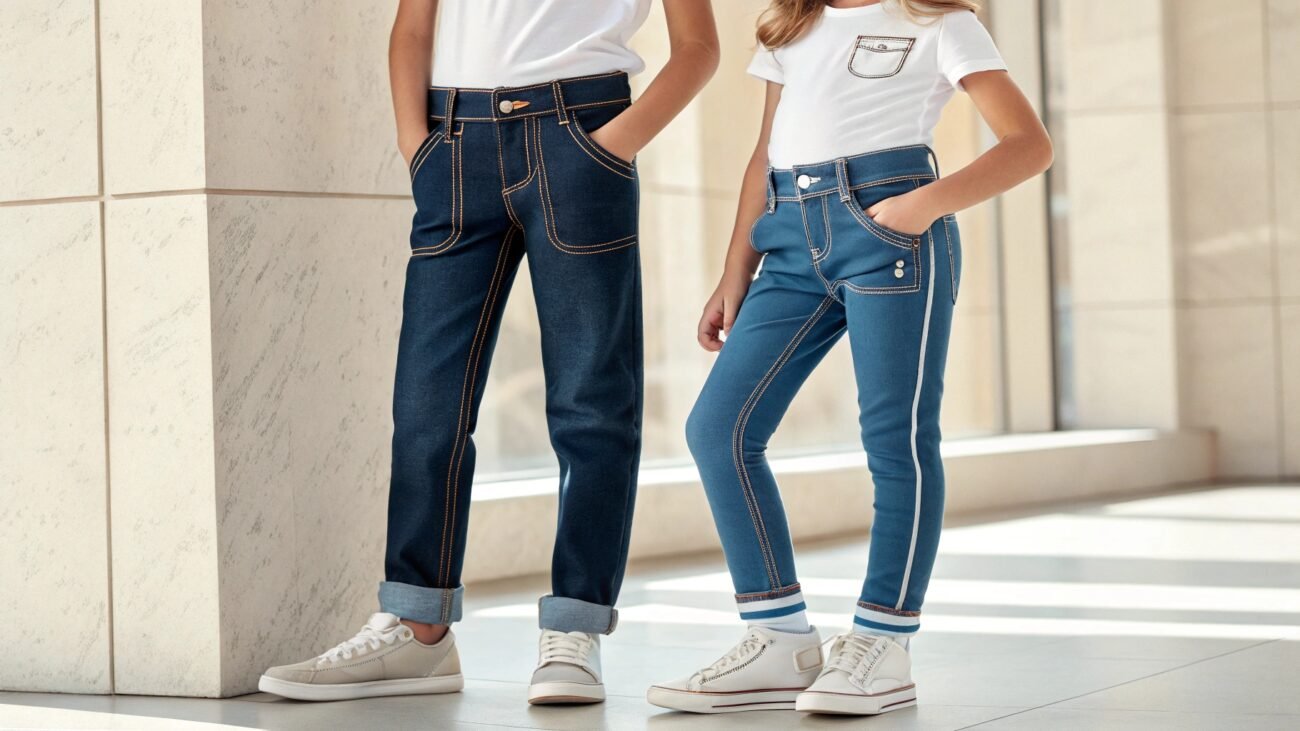Swimwear’s are not just functional pieces of garments anymore. They completely capture the thought that “Fashion can emerge from anywhere,” and if you think about it thoroughly, then that’s exactly what they had done.
Table of Contents
ToggleCurrently, there are multiple types of swimwear for both men and women, each dedicated to a specific event. You want something nice and relaxing for beach parties? Or something a bit more focused towards water sports? there is probably a swimsuit designed specifically for you.
Join us, and we will tell you everything that you need to know about swimsuits! Their types, associated fabrics and even ongoing trends. In a nutshell, this blog will be your freemium guide.
What Constitutes Great Swimwear?
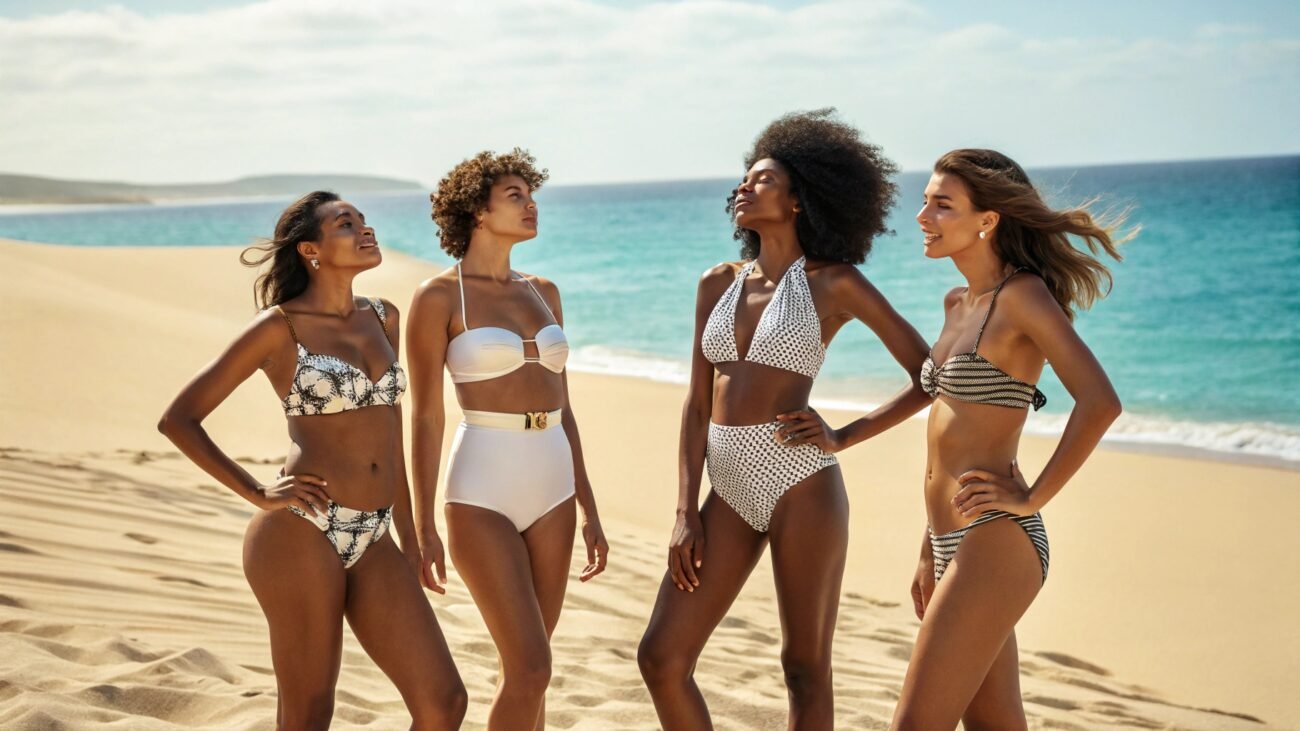
Arguably, anything can be worn to beaches and pool parties, but clothes made out of traditional materials often lead to discomfort and dull evenings.
However, there has to be something special about swimsuits, given the fact its industry is now being projected to grow to 25.9$ billion dollars by 2033.
Great Swimwears are specifically designed to keep wearers not just comfortable but also viable for a long time.
Think of it from this perspective: Generally, a swimsuit would cost almost 3x that of a t-shirt or a pair of pants. Owing to this expense, these clothes should also be durable, right?
Here are some key attributes every “fine” swimming suit should have:
- Great Fit: No matter what type of swimwear, it should always come with proper fitting. Now, what does that mean? Well, great-fitted clothes mean that they stay snug on the body without causing any form of irritation.
- Fitting can either be loose or tight.
- UV-Guarding: Swimming sports or activities are rarely held indoors and are mostly in the wide prickling heat of the sun. Your swimwear should be treated with anti-UV coatings or made with fabrics that are UV-resistant on their own. Ensuring this step means not just safety from sunburns but also the risk of skin cancers.
- Shape Conserving: Being exposed to various water hazards along with tears and pulls can ruin any garment, but this should not be an expected outcome with high-quality swimsuits, as they are mostly made using materials that reform to their original shape. This re-shaping ability significantly adds up to the total resiliency of clothes.
- Lightweight: You may have noticed that it’s nearly impossible for anyone to wear thickweight suits at beaches or swimming pools.
The main reason for that is a swimming suit should be lightweight, like a gentle barrier on the skin, and should not compromise your movement or add any amount of burden on your shoulders.
- This is why only lightweight materials should be used with minimal embellishment for making top-notch swimming suits.
- Flexibility: Swimwears are often defined by their free motion range, and imagine if that was not the case with your swimming trunks or tops, then you definitely wouldn’t be having a great time. This is why every swimwear should be flexible to accommodate body movement during water activities. This attribute also reduces the risk of muscle injuries.
Why Should You Build a Swimming Suits Wardrobe?
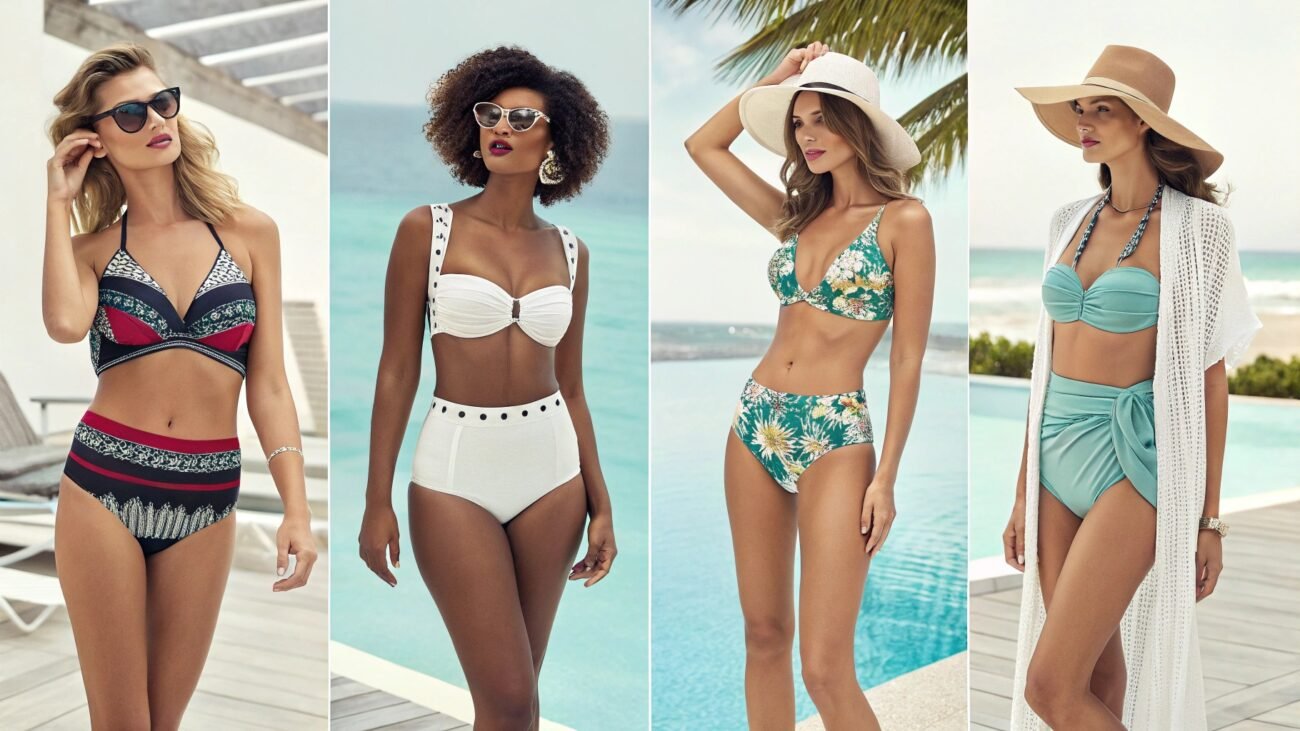
It may not seem much, but think about all the possibilities; swimwear garments are not just restricted to beaches and pools. Rather, they can also be worn for casual parties and have the potential to be dressed as statement outfits. A good wardrobe, no matter the clothing type, is always ready for all occasions.
Consider these points to make a wonderful swimming suits closet for vacations and casual meetups!
- Activity Level: Consider what you will be doing most of the time, whether it is lounging or active swimming.
- Fitness & Leisure: No matter what swimming piece you may have or are planning to acquire, it should be fitted to your body with good levels of comfort.
- Fabric Choice: Always go for fabrics that are lightweight and flexible. Opting for additional functionalities such as UV-guard and DWR-coatings is also a good option.
- Personal Styles: Your wardrobe should symbolize who you are! Experiment around with different pieces with various colours and printed swimwear designs.
- Versatile Pieces: Despite being a guy who likes to lounge around, you should still have some semi-performance suits in your wardrobe. The same could be said for water athletes as well: invest in counterparts.
- Budget: A great wardrobe needs strategic planning; even with an open budget, people still fail to create a functional closet. Always try to balance out quality with the funds at hand.
Common Types of Men’s Swimwear
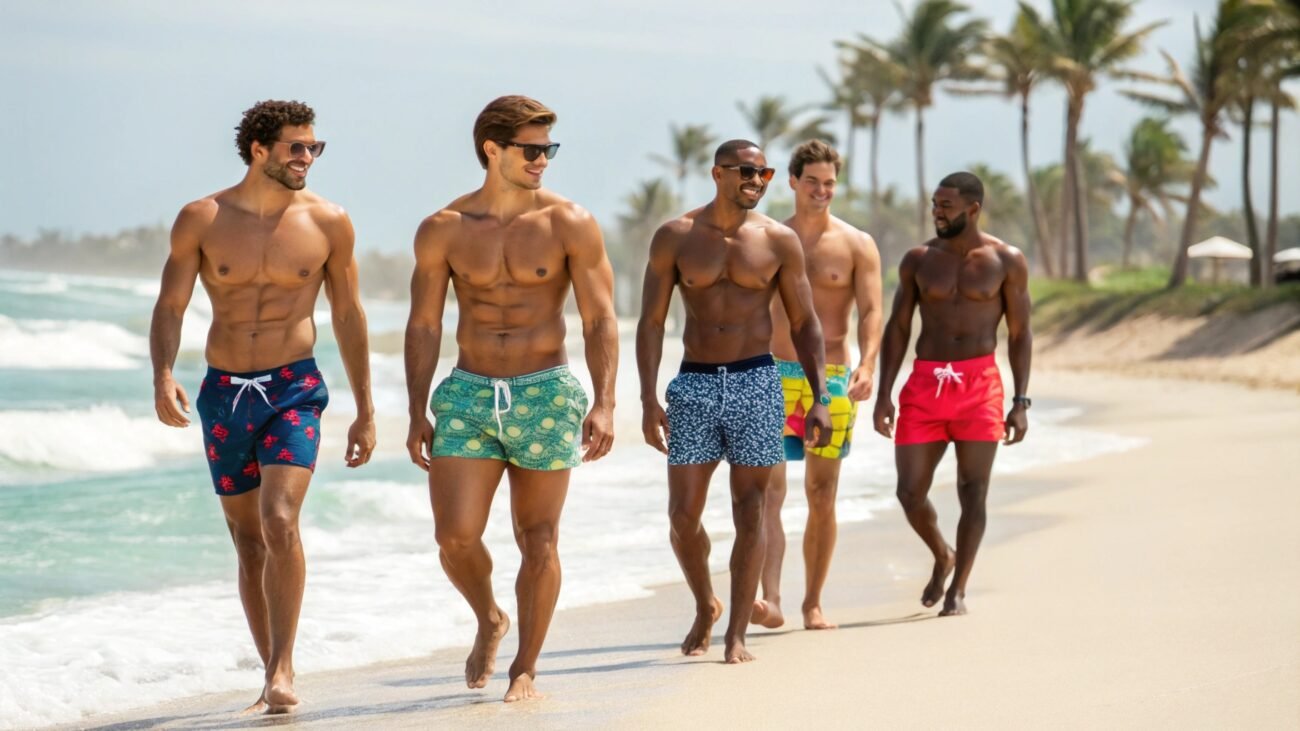
1) Swimming Trunks:
The most common and versatile option out there, swimming trunks feature a loose fit with a drawstring waistband that can be adjusted depending on the nature of the tasks at hand. For greater support, many trunks come with mesh linings as well.
Point of Distinction:
Elastic waists, often called trunks, come with different lengths ranging from ones extending till mid-thigh and some even slightly longer for streamlined performance in casual sports.
2) Board Shorts:
These shorts were originally meant for surfers, but when they regained a bit of popularity, even non-surfers started to opt for them as they are free movement facilitating and come with useful features like quick drying and velcro fly closure. However, unlike swimming trunks, board shorts have a fixed waistband.
3) Swim Briefs:
Speedos, commonly referred to as swim briefs, are exactly what you might be thinking. They are men’s briefs made with nylon-spandex or poly-spandex blends to confer higher form fitting and storeability factor. Structurally speaking, swim briefs have high-cut leg openings and a V-shaped front, which are specifically useful to minimize water drag.
4) Square-leg Swimsuits:
A middle-ground option for those who neither like swim briefs nor shorter trunks. Square-leg swimsuits for men are like form-fitting briefs but with boxer-style cuts. They offer higher coverage as compared to briefs and are streamlined.
>What Are Some Drawbacks of Euro Trunks?
Square-leg swimsuits, often known as euro trunks, have the potential to be less flattering due to straight leg cuts that can make legs appear wider. Additionally, the extra fabric also adds up to weight and drag potential.
5) Jammers:
When high performance is needed, then what could be a better option than tight-fitting jammers? They extend just below from the waist to the knees. Similar to cycling shorts, they aim to provide strategic compression and support for longer playtime.
Noteworthy Detail: You may think jammers are exclusively for athletic activities due to the use of stretchy materials like spandex or lycra. They can also be worn in casual recreational games because of their elevated comfort and support.
6) Hybrid Shorts:
Seamlessly designed and made with quick-drying fabrics that are resistant to water damage. Hybrid shorts look exactly like any other high-end shorts but can be worn for full-fledged swimming and casualwear.
>What is “Hybrid” About These Shorts?
Hybrid shorts are called hybrid because of their unique blend of functionality and casual wearing potential. They come with waster-repellent fabrics for swimming and are styled with button flies and pockets for everyday use.
Create Custom Swimwear’s!
PLCM have been the backbone of many couture fashionable swimwear brands and we remain on top by providing exceptional quality and low MOQs. We understand what you need.
Must-Have Swimmers For Ladies
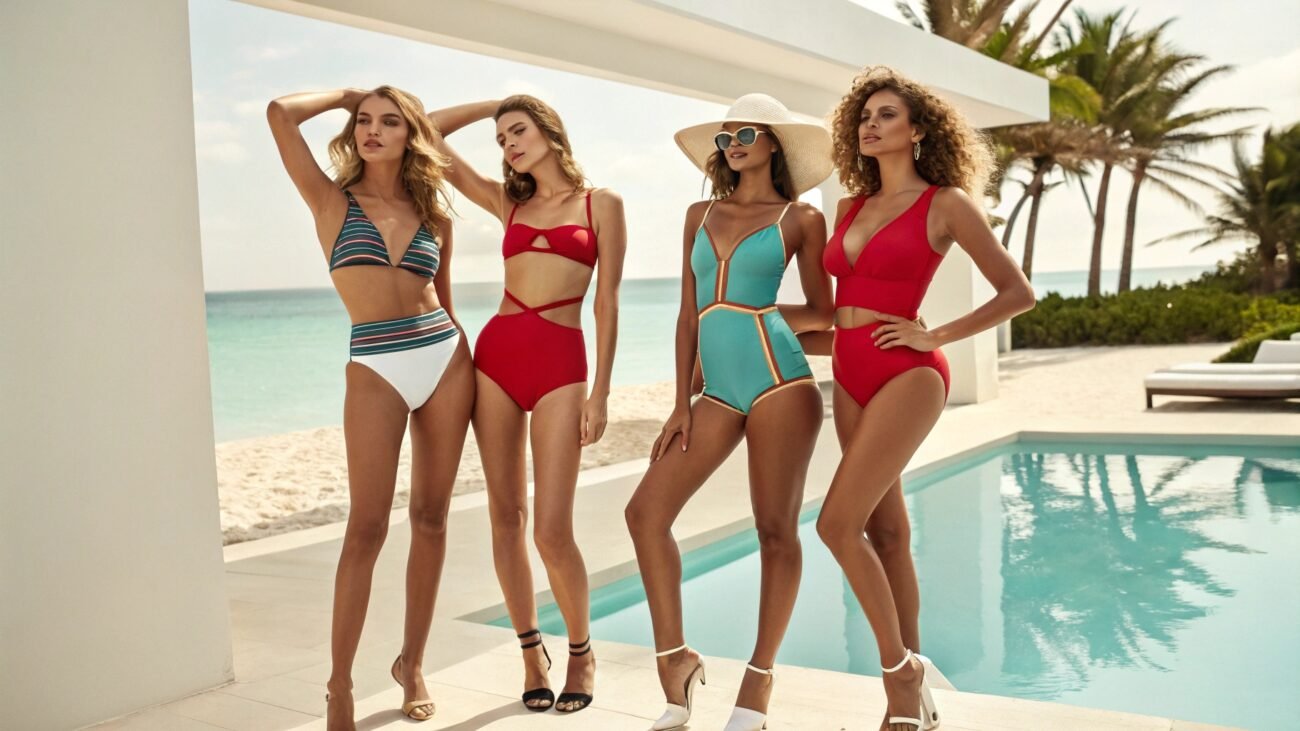
1) One piece:
One piece dominates the market right now and is versatile beyond words! They come in endless variations ranging from plunged necklines, high-cut leg openings and ruching for tummy control. Onesies offer moderate coverage and are very flattering to wear for swimming and getting those golden tan lines.
Most renowned types of one piece suits:
- Halter Necks
- Classic Tank suits
- Bandeau
- One-shoulder suits
2) Bikinis:
Who doesn’t know about bikinis? These are two-piece statement-making garments that have always been a topic of discussion, but nobody can deny their use and serviceability as a fashion icon.
Premium bikinis are as popular as they are right now because of the following properties:
- Adjustable ties for customizable fitting.
- Underwiring for exceptional breast support and lift.
- Great for minimizing tan lines.
Fun Fact: Any part of bikinis, whether tops or panties can be referred to as a bikini. So don’t be surprised if you ever find someone referring to their underwear as a pair of bikinis.
3) Tankinis:
Another spin on bikinis, but tankinis come with tank top styles, which automatically translate to higher coverage and are available in various lengths and styles, such as flowing to tight fitting options. You may find it hard to believe, but tankinis are better at swimming than bikinis as they feature a larger top, which somewhat helps out with water drag and gives off an aerodynamic appeal.
4) Swim Dresses:
Swim dresses are unique pieces for women, as they aim to provide modest coverage whilst still silhouetting that feminine charm. These are either one-piece or two-piece and feature a skirt-like extension if skirted swimsuits are what you want.
5) Rash-Guards:
Another story of transitioning from functionality to fashion. Rash guards were often used by surfers but are now adopted by casual beachgoers who want a quick solution against the sun’s radiation. When specifically talking about ladies’ swimsuits, rash guards can be worn over bikini tops or even as a standalone top.
Some other serviceability:
- Abrasive resistant.
- Snug fitting.
- Breathable.
- Comes with shorter & longer sleeve lengths.
6) Specialty Swimmers:
Specialty swimwear, as the name suggests, is a types of swimwear tops and underwear that are designed for a very niche purpose.
For better understanding, take a quick look at the sub-types:
- Racing Suits: Designed for competitive swimming and can not be used otherwise.
- Wetsuits: Thicker and heavier swimsuits that are actually designed to protect wearers from cold water. (For extreme challenges).
- Maternity Swimsuits: Specially created for pregnant ladies, they offer more room for flexibility and stretch for that belly bump.
For in-depth knowledge about different swimsuits for women
Check out this blog: Making Waves: A Deep Dive into Every Types of Swimsuits for Females
Fabrics in Swimwear Line-up
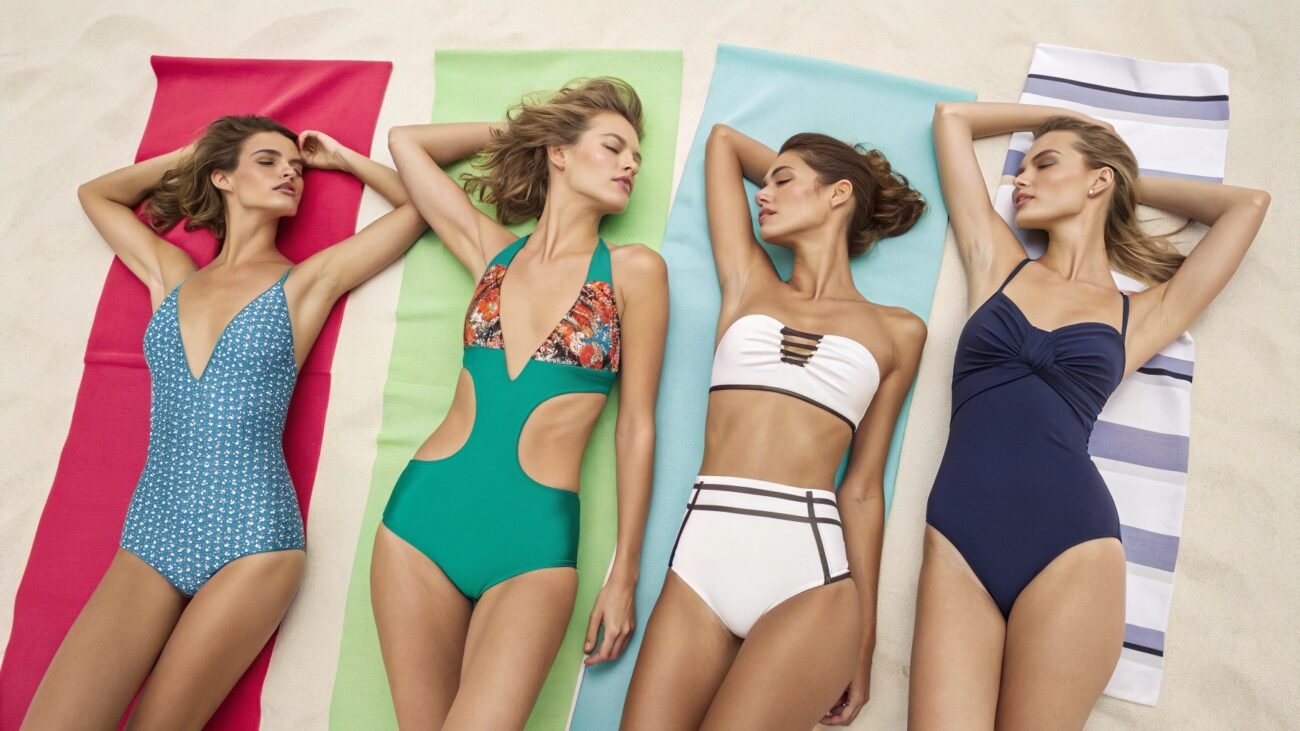
As mentioned beforehand, functional swimwear can only be manufactured using specialized fabrics, and if this regime is not followed, then the resulting garments will fail miserably.
1) Nylon:
Nylon is a lightweight, soft fabric with good stretchability and fast drying capabilities. It is often used in many types of swimwear due to its comfort and flattering drape. Unless blended with other fabrics, it can get damaged rather quickly by UV radiation.
2) Polyester:
In contrast to nylon, Polyester is excellent against UV radiation and chlorine. It is the best fabric choice when printed designs are concerned as it is made up of plastic fibres that hold colour for a long time. However, it is not as soft and stretchy as nylon but is preferred in competitive swimming due to its tear-free resilience.
3) Spandex:
You’d be surprised to know that almost every swimwear contains a percentage of spandex, on its own, it can’t be used to make clothes, but when blended rightly with nylon or polyester. It becomes something transcendent. Spandex is known for its high shape recoverability and good fitting.
4) PBT (Polybutylene Terephthalate):
A type of polyester with properties that can only be achieved through poly-spandex fabric blends. It is highly durable and resistant to chlorine, which makes it a perfect choice for the modern swimwear lineup.
5) Neoprene:
Remember we talked about specialty swimwear? Neoprene is mostly used to fabricate those sets of clothes owing to its excellent insulation, buoyancy and waterproofing qualities.
Eco-friendly Fabrics For Swimming Suits
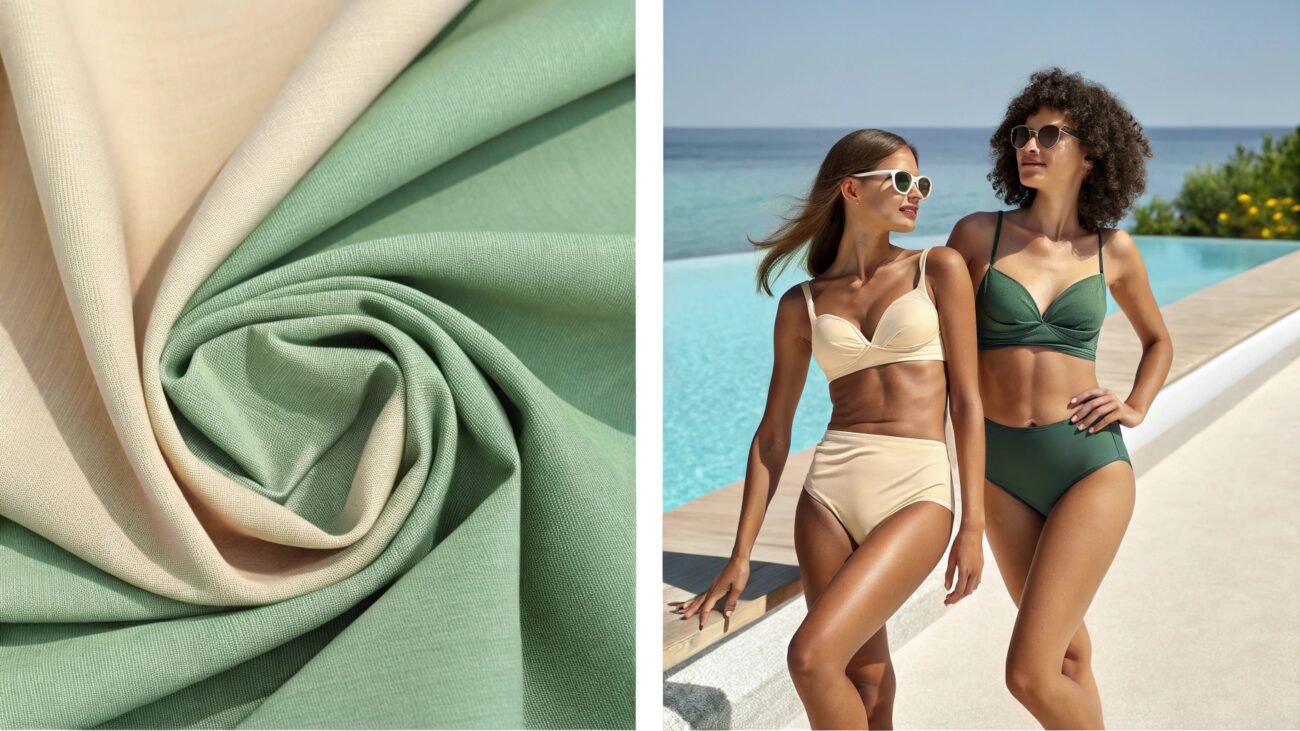
With ever-increasing awareness regarding the harmful effects of the tactile industry, many sellers and buyers are opting for less impactful solutions for swimwear.
1) ECONYL:
A type of regenerated nylon made from nylon that offers the same functionality as virgin nylon.
2) Recycled Polyester:
Similar to ECONYL, Recycled polyester is made from plastic waste, which means less electrical consumption and low environmental impact. Recycled polyester is just as good as traditional polyester.
3) Repreve:
Made from recycled PET bottles and has good thermoregulative properties alongside durability and moisture wicking.
Which Swimming Suit should I get?
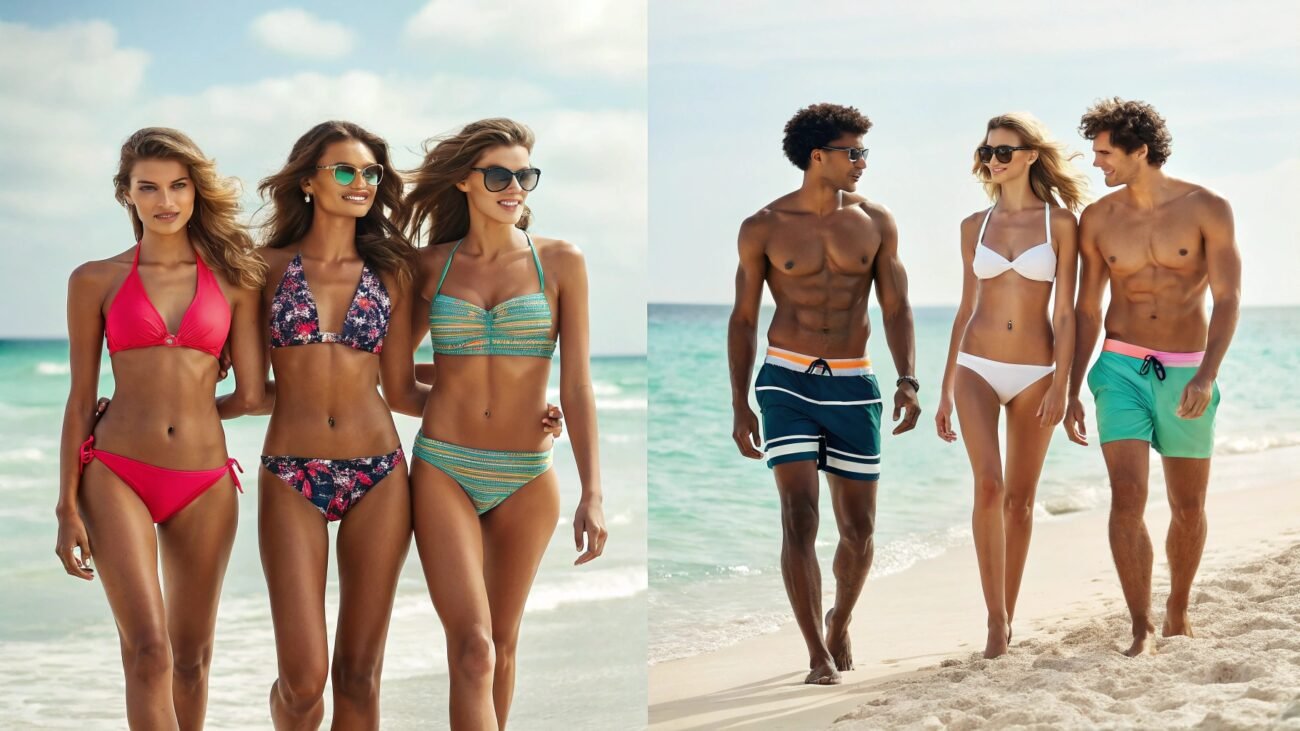
Other than personal preferences, there are some guidelines through which you can make an informed choice!
> For Men:
- Activity Level: Consider what you will be doing most of the time. Here take a look at this quick table to decide your swimsuit type.
| Types of Swimwear | Best For? |
|---|---|
| Swimming Trunks | Casual Swimming & lounging by the beach or pool. |
| Board Shorts | Surfing & paddle boarding. |
| Swim Briefs | Competitive lap swimming & sunbathing for maximum tan. |
| Square-leg Swimsuits | Recreational swimming & fitness swimming. |
| Jammers | Competitive swimming, triathletes. |
| Hybrid Shorts | Vacations. |
- Comfort: If higher coverage and free body motions are concerned, then go for trunks and hybrid shorts. Otherwise, jammers and swim briefs are best for higher support and snug fitting.
- Style: Try to think about the final desired appeal. Hybrid and board shorts look much more fashionable with printed designs than options like briefs and square-leg swimsuits.
- Material: If moisture wicking is your top priority, then go for polyester-based blends; however, for quick drying and stretchable factors, nylon is a great option.
> For Women:
- Activity: Analyse your lifestyle and pick what’s best for you. If you are an athletic person, then go for one piece and special swimmers; otherwise, for casual lounging, go for tankinis and swim dresses if coverage is a higher concern. Otherwise, for free movement, opt for bikinis.
- Support: Bust support is a crucial factor to consider when buying swimsuits, bikinis and tankinis for fuller busts and onesies for smaller chests.
- Style and Color Matching: If your fashion sense leans more towards minimalism, then the option for monochromatic shades will give you that sleek and serious look; otherwise, for bold fashion statements, primary colours (Red, Blue and Green) along with custom design printing is best.
Valuable Read: Comprehensive Guide: How to Understand Color Theory For Fashion
- Sun protection: It might not seem much, but different types of swimwear for ladies have different levels of body exposure to sunlight. Depending on the tan, choose swimsuits accordingly.
- Body Type: Body type is a deciding factor, but going through this route can save you plenty of time as some body shapes are ill-fitted to some clothes and still choosing said garments can cause extreme discomfort and leave a bad taste in your mouth.
- Here’s how you can quickly find which swimsuit complements which body type.
| Body Shapes | Best Swimwear |
|---|---|
| Pear (Heavier Bottom) | One piece or Tankinis |
| Apple (Fuller Midsection) | Tankinis or Swim dresses |
| Hourglass (Well Balanced) | One-pieces or Bikinis |
| Rectangle (Straight) | One-pieces or Bikinis |
| Inverted Triangle (Heavier Top) | One piece or Tankinis |
Quick Note: One piece is the only swimwear that complements most body types.
Main Takeaways of Blog
- A great swimming suit should be lightweight and durable.
- Building a swimming wardrobe can be very beneficial; it equips you with necessities for outdoor water games and even relaxing vacations.
- Both Men and Women’s swimwear can be categorized into casual, recreational and athleisure.
- One-piece swimming suits and Hybrid shorts are some of the most worn swimwear.
- Nylon, Polyester and Spandex are best for making high-end suits, but eco-friendly options such as ECONYL and REPREVE are just as good.
- Selecting the right swimwear should be based on preferences, functionality and activity level.
FAQs
1) Which fabric offers the best resistance against chlorine and UV?
Polyester and PBT are highly recommended for their excellent chlorine and UV resistance. Being resistant to these elements also means higher durability and colour fastness.
2)Do you need to wear underwear under swimsuits?
Remember this right-hand rule, if your swimwear has great tight fitting, then you do not need to wear anything underneath, but if we are talking about loose-fitted clothes like swimming trunks and swim dresses, then yes, wearing underwear can be very beneficial.
3) Are there any swimming suits for concealing my tummy?
Yes, there are some options, such as one piece with ruched front panels for concealing tummy fat, and swim dresses are also a great option

